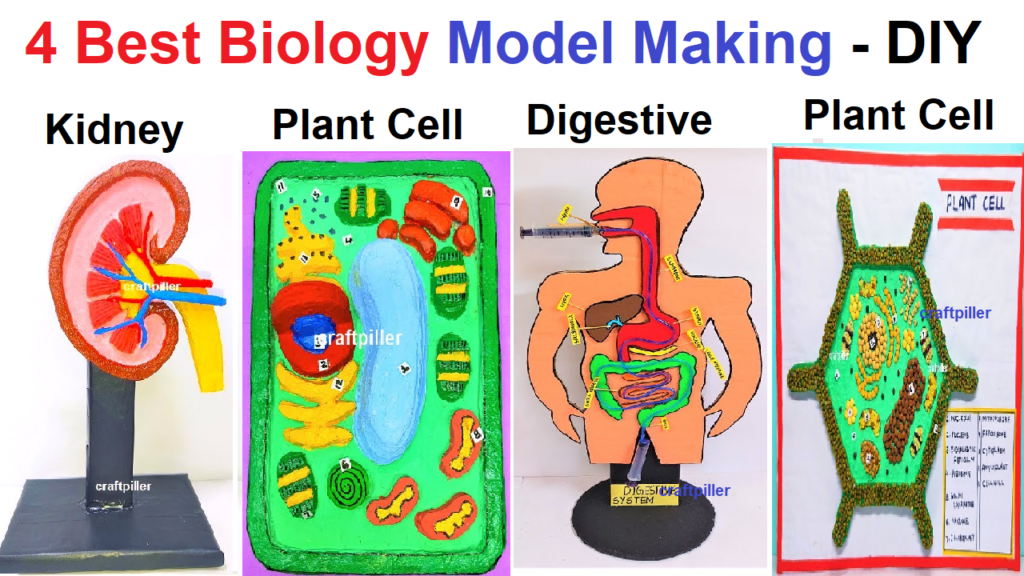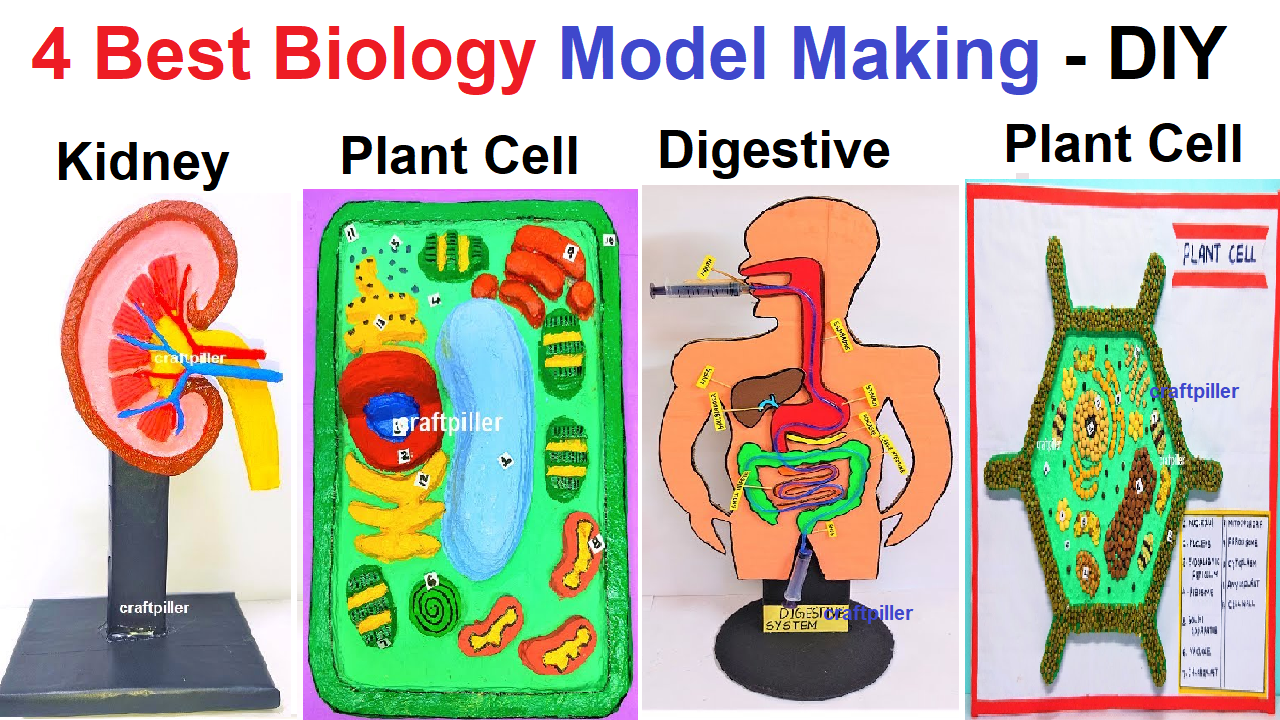The field of human biology and health is vast and multifaceted, encompassing everything from the structure and function of our organs to the factors influencing our physical and mental well-being.
Science project models provide an effective means to delve into these topics and communicate essential information to a wider audience.
Creating science project models related to human biology and health can be a fascinating and educational endeavor. Here are 50 science project model ideas in this field:

1. Digestive System Model:
Build a 3D model of the digestive system to illustrate how food is processed.
2. Respiratory System Model:
Create a model of the respiratory system to demonstrate how breathing works.
3. Circulatory System Model:
Build a model of the heart and blood vessels to show blood circulation.
4. Skeletal System Model:
Construct a model of the human skeleton using materials like straws or clay.
5. Muscular System Model: Create a model showcasing muscles and their functions.
6. Nervous System Model:
Build a model of the brain and nerves to explain the nervous system.
7. Skin Layer Model:
Design a model representing the layers of the skin and their functions
8. Eye Model:
Create a model of the eye to demonstrate how vision works.
9. Ear Model:
Build a model of the ear to illustrate hearing mechanisms.
10. Kidney Model:
Create a model of the Kidney model to explain kidney operations.
11. DNA Double Helix Model:
Construct a DNA model to demonstrate its structure.
12. Plant Cell Model:
Build a 3D Plant cell model to illustrate cell organelles and their functions.
13. Animal Cell Model:
Build a 3D Animal cell model to illustrate cell organelles and their functions..
14. Respiratory System Model (Lung Expansion):
Use balloons to represent lungs and show how they inflate and deflate during breathing.
15. Human Heart Pump Model:
Build a model that simulates the pumping action of the heart.
16. Dental Health Model:
Design a model of teeth and gums to teach about dental hygiene.
17. Sperm model :
A sperm model is a scientific representation designed to illustrate the structure and function of sperm cells, which are fundamental to human reproduction and the continuation of the species.
These models provide an invaluable educational tool for students, researchers, and healthcare professionals to better understand the microscopic world of human reproductive biology.
18. Hemodialysis working model:
A hemodialysis model is a visual and often interactive representation that illustrates the process of hemodialysis—a life-saving medical procedure used to treat individuals with kidney failure or end-stage renal disease (ESRD).
Hemodialysis models serve as educational tools to help patients, healthcare professionals, and students understand the complex and vital process of filtering waste and excess fluids from the blood when the kidneys are unable to do so.
19. Bone Model :
A bone model is a three-dimensional representation of human or animal bones used for educational, scientific, and medical purposes.
These models are valuable tools for studying the anatomy, structure, and function of bones in the skeletal system.
Bone models come in various forms, from simple plastic replicas to highly detailed anatomical models, and they play a crucial role in enhancing our understanding of the skeletal system’s complexity.
20. Blood Vessel Network Model: Create a model of the circulatory system to showcase blood vessel networks.
21. Human Reproductive System Model:
Build a model illustrating male and female reproductive organs.
22. Organ Transplant Model: Design a model demonstrating organ transplantation procedures and challenges.
23. Digestive System Enzyme Activity Model:
Illustrate how enzymes work in the digestive system using simple materials.
24. DNA Replication Model: Create a model to show how DNA replicates during cell division.
25. Bacteria Model:
Create models of Bacteria to explain their structures and functions.
26. Virus Model:
Create models of viruses to explain their structures and functions.
27. diaphragm model:
3D diaphragm model is a visual representation designed to illustrate the structure and function of the diaphragm, a critical muscle involved in the process of breathing and respiration.
The diaphragm plays a central role in expanding and contracting the lungs, allowing for the exchange of oxygen and carbon dioxide.
These models are valuable educational tools that help students, healthcare professionals, and individuals interested in human anatomy better understand the anatomy and mechanics of the diaphragm.
28. Neuron model:
A neuron model is a visual representation that helps illustrate the structure and function of neurons, the specialized cells that form the building blocks of the nervous system.
Neurons are responsible for transmitting electrical signals throughout the body, allowing for the communication of information within the nervous system.
Neuron models serve as educational tools to help students, researchers, and healthcare professionals understand the anatomy and function of these crucial cells.
29. Mouth – Teeth Model:
A mouth and teeth model is a visual representation designed to illustrate the anatomy and structure of the human mouth, including the teeth, gums, tongue, and other oral structures.
These models are essential educational tools used in dental education, biology classes, and health-related settings to help students and patients understand the complexities of oral anatomy and oral hygiene.
30. Human Brain Neurotransmitter Model: Illustrate neurotransmitters and their role in brain function.
31. Human Circadian Rhythm Model: Create a model to explain the body’s internal clock.
32. Human Brain Memory Model: Build a model of the brain to illustrate memory formation.
33. Blood Clot Formation Model: Demonstrate how blood clots form and their importance.
34. Dental Cavity Model: Create a model of a tooth with a cavity to explain dental decay.
35. Spinal Cord Model: Build a model of the spinal cord to explain its role in the nervous system.
36. Human Fetal Development Model: Illustrate the stages of human fetal development.
37. Human Senses Model: Create a model showing how the five senses work.
38. Human Eye Diseases Model: Illustrate common eye diseases and their effects on vision.
39. Human Hearing Impairment Model: Build a model explaining hearing impairments and solutions.
40. Human Body Temperature Regulation Model: Demonstrate how the body regulates temperature.
41. Human Blood Pressure Regulation Model: Create a model explaining blood pressure regulation.
42. Human Reflex Response Model: Build a model demonstrating reflex responses.
43. Human DNA Profiling Model: Create a model explaining DNA profiling and its applications.
44. Human Endurance and Exercise Model: Illustrate the effects of exercise on the human body.
45. Human Microbiome Model: Build a model illustrating the human microbiome and its importance.
46. Human Nutrition Model: Create a model of a balanced diet and its impact on health.
47. Human Sleep Cycle Model: Explain the stages of the sleep cycle using a model.
48. Human Genetic Disorders Model: Illustrate genetic disorders and their inheritance patterns.
49. Human Stress Response Model: Create a model demonstrating the body’s response to stress.
50. Human Organ System Interactions Model: Build a model showing how different organ systems interact in the body.
Choose a project that interests you the most and aligns with the resources and materials you have available. These models can serve as educational tools and provide a deeper understanding of human biology and health.

